Drancy internment camp
![]()
This article or section needs revision. More details should be given on the discussion page. Please help improve it, and then remove this tag.
The Drancy assembly and transit camp was for a time a notorious prison camp in the town of Drancy 20 kilometres northeast of Paris and gained sad notoriety as the site of the Shoah in France, from where some 65,000 mainly French Jews were transported by rail to the German extermination camps mainly in what is now Poland (Auschwitz-Birkenau and others). About 63,000 of them were murdered in these or died beforehand from the disastrous circumstances of transport, accommodation and treatment. Among them were about 6,000 children. Only 1,467 survivors were freed by a Swedish envoy and representative of the Red Cross together with the Allied Forces on August 18, 1944. Nine out of ten deported French Jews were taken to the East via Drancy. Initially under French command, SS Hauptsturmführer Alois Brunner took command of the camp on July 2, 1943, assisted by four SS officers. The French staff was dismissed. They used prisoners as camp police ("Membres du Service d'Ordre"). The other large French collective camps for Jews were located in Compiègne (Royallieu) (Oise department), Pithiviers (Loiret) and Beaune-la-Rolande (Loiret).

cash withdrawal receipt
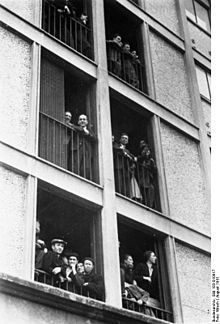
Drancy internment camp in August 1941, photograph of the propaganda company
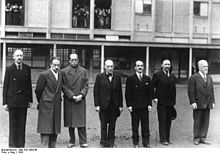
Jewish-French lawyers interned at Drancy. From left to right: Weill, Valensi, Azoulay, Ulmo, Cremieux, Eduard Bloch and Pierre Mas.
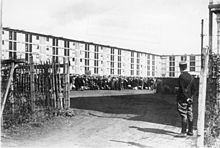
Prisoners in the yard of the camp, August 1941
History
The Cité de la Muette complex was built between 1932 and 1934 according to plans by architects Marcel Lods and Eugène Beaudouin and was one of the first large housing estates to be built in France as part of the social housing programme of the interwar period. In October 1939, the public housing complex became a police barracks with an internment camp for militant communists. After the German occupation of France in May and June 1940, the building complex was requisitioned by the German Wehrmacht; French prisoners of war were initially imprisoned here, and later Yugoslav and Greek civilians. In October 1941, the site was transformed into the main detention camp for Jews, but also for members of other ethnic or social minorities.
Like other detention centres in France, the Drancy assembly camp had been set up on the orders of the occupying power under the auspices of the Higher SS and Police Leader in France, later the SD, and had been under the control of the SS until July 1942 under SS-Hauptsturmführer Theodor Dannecker, until June 1943 SS-Obersturmführer Heinz Röthke, and from 3 July 1943 under SS-Hauptsturmführer Alois Brunner. It had been chosen because of its proximity to the large marshalling yard. The camp was opened after a manhunt against Parisian Jews in August 1941, when 4,000 people were arrested. Further waves of arrests against Jews were carried out by the French police on the orders of the Vichy regime of Marshal Philippe Pétain from 1941 to 1944, not only in the occupied zone but also in the "unoccupied" southern zone. These were also directed against the Jews who had fled from Germany and Austria to southern France and were waiting in internment camps for their visa, passage by ship or departure to a country without persecution (mostly the United States or also Mexico, Cuba, China or for the transit visa for Spain or Portugal).
The camp at Drancy was a four-story, U-shaped complex of buildings around a courtyard about 400 meters long and about 40 meters wide, originally designed to hold 700 people, but at its peak more than 7,000 people were confined there. The horseshoe-shaped camp was surrounded by barbed wire and watchtowers at all four corners, and was guarded by French gendarmes. Based on documentary evidence and witness testimony, the inhumane conditions and brutality of the French guards at Drancy have been proven, which included the immediate separation of young children from their parents upon arrival.
Klaus Barbie, the notorious "Butcher of Lyon", kidnapped all the Jewish children he could get hold of during searches of French children's homes and took them to Drancy, from where they were all sent to Auschwitz to be murdered (see also: Children of Izieu).
As late as November 1941, about 800 interned sick people under the age of 18 had been released. In December 1941, 40 prisoners from Drancy were executed in retaliation for a French attack on a German police officer. The military commander in France, Otto von Stülpnagel, received repeated demands from the Wehrmacht High Command in Berlin for hostage shootings in retaliation for Resistance attacks on German soldiers and police officers. In response, Stülpnagel, for his part, demanded at the end of 1941 the deportation of "larger masses of Jews and Communists to the East" because it would have "a much more deterrent effect on the French population than mass shootings, which they do not understand."
In the same month, Walter Bargatzky, a lawyer who was part of the command staff of the German military administration at the Hotel Majestic, received for the first time a detailed eyewitness account of the mass killings north of Kiev at Babi Yar. This account quickly circulated among the German staff. Initially, it was thought that the mass killings may have occurred on local occasions and at local sites. But when, after the Wannsee Conference, Reinhard Heydrich gave an exclusive lecture to the higher ranks of the Hotel Majestic on 7 May 1942, in which he spoke of attempts to kill Jews by means of specially prepared trucks whose exhaust gases were intended to kill the deportees, and in this connection the word "gassing" was used for the first time, there was no longer any doubt in the minds of those present as to the fate of the Jews of Drancy. On this occasion Heydrich introduced the new police and SS leader of Paris, Carl Oberg, who, unlike his predecessors, no longer had to rely on the assistance of the military commander of the French authorities, but was now given direct powers to deport. He was notorious for his harassing behavior, whether by forbidding music, card games, or dancing, or by refusing to send aid packages from relatives and relief organizations to the camp inmates. After the raid on the Vélodrome d'Hiver, during which more than 13,000 Jews were arrested on July 16 and 17, 1942, childless married couples and unmarried persons were first taken to Drancy.
Since Allied air raids took place on Parisian marshalling yards, through which the deportation trains rolled day and night, it happened that sealed wagons burst open as a result of the bombing and prisoners escaped. In order to be able to distinguish these from others more quickly, those responsible came up with the perfidious idea of transporting Jews only naked. For this reason these transports were called "naked transports". Bargatzky, who belonged to the German resistance of July 20, 1944, and who was chosen to prosecute those responsible for the occupation crimes if the assassination attempt succeeded, had collected these details in order to make them the basis of a charge of "Wehrkraftzersetzung" against the SD leaders.
According to research by Serge Klarsfeld, 42 convoys with 40,450 deportees left Drancy via the Bourget-Drancy station between 27 March 1942 and 23 June 1943. 21 convoys with 22,450 deportees were transported to their deaths via the Bobigny station in the north. 58 of these transports reached Auschwitz-Birkenau, two death trains each went to Majdanek and Sobibor, and one to Kaunas and Reval. Until July 1943 the trains were accompanied by SS guards and French gendarmes. After that, the police from Germany also arrived.
Many French Jewish intellectuals and artists were imprisoned at Drancy, including Max Jacob (who died in the camp in 1944), the philosopher Tristan Bernard and the choreographer René Blum.
One prominent interned person was Fania Fénelon, a singer from Paris. Her father Jules Goldblum was Jewish. She was caught supporting communist actions, arrested by the Gestapo and sent to the Drancy transit camp. From there she was sent on to Auschwitz, where she was a member of the Auschwitz Girls Orchestra, led by Alma Rosé. She survived the concentration camp and the death march and was liberated by the British. Alma Rosé was also interned in this camp for six months until her deportation on 18 July 1943. Luise Straus-Ernst, a respected cultural journalist in Weimar Germany and the first wife of the surrealist Max Ernst, was discovered in her hiding place in the south of France, arrested and interned at Drancy. On 30 June 1944, she was deported to Auschwitz on the penultimate train.
In the course of the liberation of Paris, 1,467 prisoners were freed on August 18, 1944, after the arrival of the Swedish consul Raoul Nordling, who prevented the destruction of the city, and members of the Red Cross.
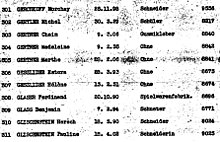
Deportation list Drancy-Auschwitz of 7 December 1943 (excerpt)

Registration sheet in the transit camp Drancy. The prisoner Ferdinand Glaser arrived on 24 November 1943 and was deported to Auschwitz on 7 December 1943.
The camp today
In 1976, the sculptor Shlomo Selinger created the Deportation Memorial in memory of the French Jews imprisoned here, located in the La Muette neighborhood. Part of the memorial is the Wagon-Témoin (Witness Wagon), opened in 1988. The buildings of the camp contain social housing, as originally intended.
Officially, in France, until recently, the Vichy regime was referred to as the "illegal governing body of the French Republic". Although the criminal behaviour of the Vichy regime and the collaboration of ten French gendarmes were accused, even some representatives of the Vichy regime were convicted (e.g. Pétain, Pierre Laval, Paul Touvier, Maurice Papon) the co-responsibility of the French Republic was denied for a long time. On 16 July 1995, however, President Jacques Chirac, in a speech, acknowledged the French State's complicity in the "criminal madness of the occupier".
On 20 January 2005, arsonists set fire to some cattle cars in the former collection camp. A leaflet signed "Bin Laden" with an inverted swastika was found on site.
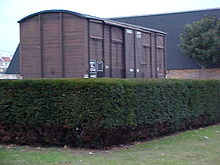
The witness wagon in La Muette as a testimony to the deportation
Questions and Answers
Q: What was the Drancy internment camp?
A: The Drancy internment camp was a concentration camp in France during the Nazi occupation of France in World War II.
Q: Who were sent to the Drancy internment camp?
A: The Drancy internment camp was organised in 1941 to collect French Jews and particularly foreign Jews who had escaped to France before the invasion by the Germans.
Q: Where were the people in Drancy internment camp sent to?
A: The people in the Drancy internment camp were put on railroad carts and sent east, to concentration camps, from which most did not return alive.
Q: Who else was rounded up in the Drancy internment camp?
A: Nearly 70,000 people were rounded up in the Drancy internment camp, including resistance fighters, Roma people, and others considered "undesirable".
Q: Who administered the Drancy internment camp?
A: Until 1943, the Drancy internment camp was administered by French police under German supervision. After that, the French were removed and replaced by German SS men led by Alois Brunner, which increased the efficiency of the deportations.
Q: How many people remained at the Drancy internment camp when it was liberated?
A: When the Drancy internment camp was liberated in 1944, about 1,500 people remained.
Q: What happened to Alois Brunner?
A: Alois Brunner was later tried (in absence) and sentenced to death, but remained at large until his death in 2010.
Search within the encyclopedia